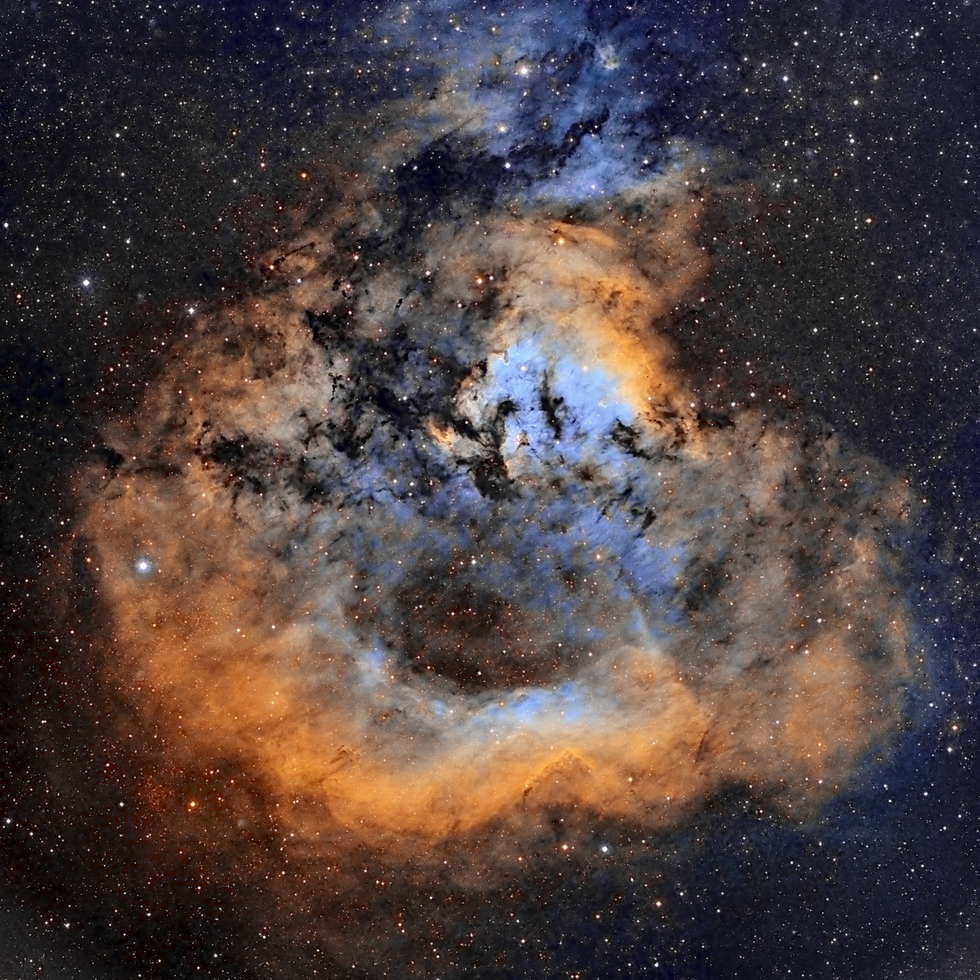What's in a name?
What's in a name?
The 'New General Catalogue of Nebulae and Clusters of Stars', compiled in 1888 by J.L. Dreyer from visual observations by the Herschels, describes the nebula NGC 7822 as "most extremely faint, most extremely large". This image, taken with Telescope Live's SPA-1 instrument, spans about 3.5 degrees on the sky, and indicates how well modern instrumentation can record such large, diffuse nebulae.
An internet search shows the same object under several other guises, including 'Cederblad 214' with surprising frequency. Sven Cederblad was a Swedish astronomer who published his catalogue of "bright diffuse galactic nebulae" in 1936; it is rarely used to identify objects today. The American astronomer Stewart Sharpless also listed the nebula as Sh2-171 in a 1959 paper, while Beverley Lynds included it as LBN 118.11+04.78 (or LBN 581) in her 1965 catalogue, describing it as "barely detectable" in the Palomar Observatory Sky Survey. And this is not to mention the embedded star cluster NGC 7762 (=Raab 151, Coll 457, Mel 244, and MWSC 3784)!
Right Ascension (RA) is the celestial equivalent of longitude, but is measured in units of time (from 0 to 24 hours). NGC 7822 is one of the last of the 7,840 objects in Dreyer's RA-sorted catalogue, suggesting that it has an RA just short of 24h. And indeed, at 'epoch 1950' (a former standard reference epoch for celestial co-ordinates), 7822's RA was 23h 58m. However, precession of the Earth's rotation axis means that celestial co-ordinates change with time, and in the current, 'J2000', reference frame its RA is 00h 01m. It has, in a sense, changed from being being one of the last objects in the sky to one of the first.
An internet search shows the same object under several other guises, including 'Cederblad 214' with surprising frequency. Sven Cederblad was a Swedish astronomer who published his catalogue of "bright diffuse galactic nebulae" in 1936; it is rarely used to identify objects today. The American astronomer Stewart Sharpless also listed the nebula as Sh2-171 in a 1959 paper, while Beverley Lynds included it as LBN 118.11+04.78 (or LBN 581) in her 1965 catalogue, describing it as "barely detectable" in the Palomar Observatory Sky Survey. And this is not to mention the embedded star cluster NGC 7762 (=Raab 151, Coll 457, Mel 244, and MWSC 3784)!
Right Ascension (RA) is the celestial equivalent of longitude, but is measured in units of time (from 0 to 24 hours). NGC 7822 is one of the last of the 7,840 objects in Dreyer's RA-sorted catalogue, suggesting that it has an RA just short of 24h. And indeed, at 'epoch 1950' (a former standard reference epoch for celestial co-ordinates), 7822's RA was 23h 58m. However, precession of the Earth's rotation axis means that celestial co-ordinates change with time, and in the current, 'J2000', reference frame its RA is 00h 01m. It has, in a sense, changed from being being one of the last objects in the sky to one of the first.
SPECIFICATIONS
Telescope
SPA-1
Camera
FLI PL9000
Location
IC Astronomy
Date of observation
2019 Oct
Filters
SHO
Processing
Pixinsight, Photoshop



